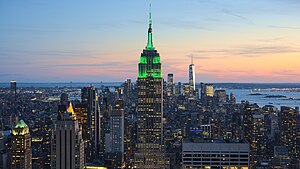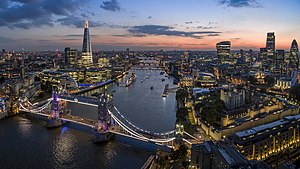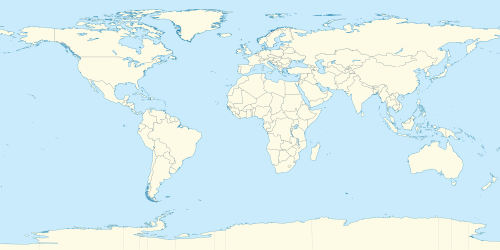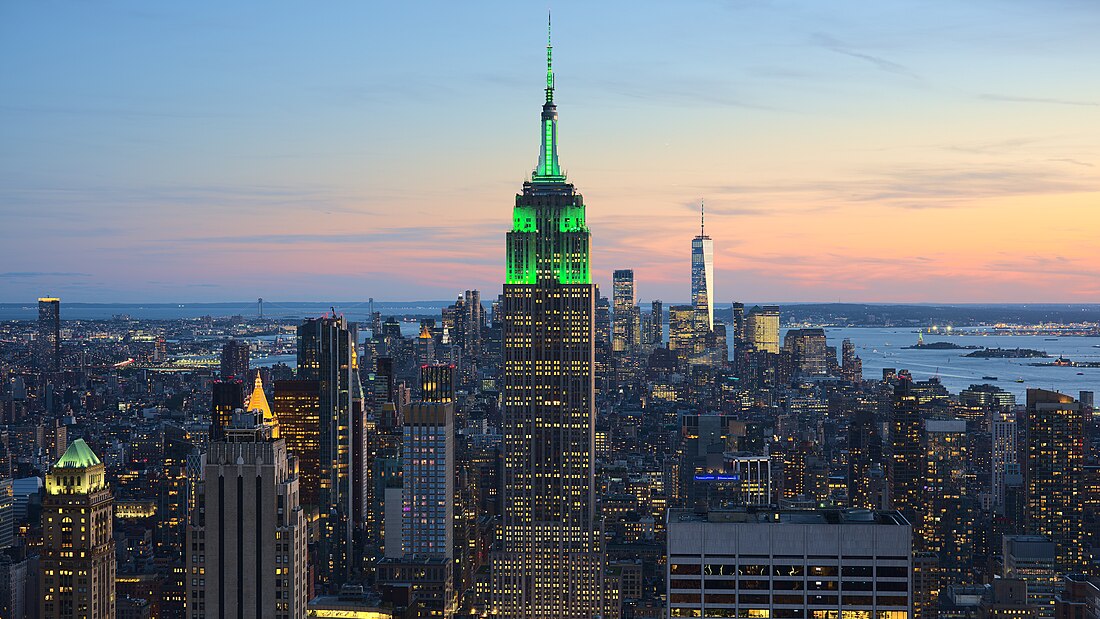A global city, also known as a power city, world city, alpha city, or world center, is a city that serves as a primary node in the global economic network. The concept originates from geography and urban studies, based on the thesis that globalization has created a hierarchy of strategic geographic locations with varying degrees of influence over finance, trade, and culture worldwide.[1] The global city represents the most complex and significant hub within the international system, characterized by links binding it to other cities that have direct, tangible effects on global socioeconomic affairs.[2]
The criteria of a global city vary depending on the source.[3] Common features include a high degree of urban development, a large population, the presence of major multinational companies, a significant and globalized financial sector, a well-developed and internationally linked transportation infrastructure, local or national economic dominance, high quality educational and research institutions, and a globally influential output of ideas, innovations, or cultural products. Quintessential examples, based on most indices and research, include New York City, London, Paris, and Tokyo.
Origin and terminology
The term 'global city' was popularized by sociologist Saskia Sassen in her 1991 book, The Global City: New York, London, Tokyo.[4] Before then, other terms were used for urban centers with roughly the same features. The term 'world city', meaning a city heavily involved in global trade, appeared in a May 1886 description of Liverpool, by The Illustrated London News;[5] British sociologist and geographer Patrick Geddes used the term in 1915.[6] The term 'megacity' entered common use in the late 19th or early 20th century, the earliest known example being a publication by the University of Texas in 1904.[7] In the 21st century, the terms are usually focused on a city's financial power and high technology infrastructure.[8][9]
Criteria

Competing groups have devised competing means to classify and rank world cities and to distinguish them from other cities.[6] Although there is a consensus on the leading world cities,[11] the chosen criteria affect which other cities are included.[6] Selection criteria may be based on a yardstick value (e.g., if the producer-service sector is the largest sector then city X is a world city)[6] or on an imminent determination (if the producer-service sector of city X is greater than the combined producer-service sectors of N other cities then city X is a world city.)[6] Although criteria are variable and fluid, typical characteristics of world cities include:[12]
- The most prominent criterion has been providing a variety of international financial services,[13] notably in finance, insurance, real estate, banking, accountancy, and marketing; and their amalgamation of financial headquarters, a stock exchange, and other major financial institutions,
- Headquarters of numerous multinational corporations,
- Domination of the trade and economy of a large surrounding area,
- Major manufacturing centers with port and container facilities,
- Considerable decision-making power daily and at a global level,
- Centers of new ideas and innovation in business, economics, and culture,
- Centers of digital and other media and communications for global networks,
- The dominance of the national region with great international significance,
- The high percentage of residents employed in the services sector and information sector,
- High-quality educational institutions, including renowned universities and research facilities; and attracting international student attendance,[14]
- Multi-functional infrastructure offering some of the best legal, medical, and entertainment facilities in the country,
- High diversity in language, culture, religion, and ideologies.
General rankings
Global city rankings are numerous.[15] New York City, London, Tokyo, and Paris are the most commonly mentioned.[16][17]
GaWC study
Jon Beaverstock, Richard G. Smith, and Peter J. Taylor established the Globalization and World Cities Research Network (GaWC). They rank world cities by their connectivity through four "advanced producer services": accountancy, advertising, banking/finance, and law.[11] The GaWC inventory identifies three levels of global cities and several sub-ranks,[19] although the authors caution that "concern for city rankings operates against the spirit of the GaWC project" [emphasis in original].[20] The 2004 rankings added several new indicators while continuing to rank city-economics more heavily than political and cultural factors. The 2008 version of the list, similar to the 1998 version, is sorted into categories of Alpha world cities (with four sub-categories), Beta world cities (three sub-categories), Gamma world cities (three sub-categories), and cities with High sufficiency and Sufficiency presence. The cities in the top three classifications in the 2022 edition are:[21]
Alpha ++
Alpha +
Alpha
Global Cities Index (Kearney)
In 2008, the American journal Foreign Policy, working with the consulting firm A.T. Kearney and the Chicago Council on Global Affairs, published a ranking of global cities based on consultation with Saskia Sassen, Witold Rybczynski, and others.[22] Foreign Policy noted that "the world's biggest, most interconnected cities help set global agendas, weather transnational dangers, and serve as the hubs of global integration. They are the engines of growth for their countries and the gateways to the resources of their regions."[23] The ranking is based on 27 metrics across five dimensions: business activity, human capital, information exchange, cultural experience, and political engagement.[24] Since 2015, it has been published with a separate index, the Global Cities Outlook, which is a projection of a city's potential based on rate of change in 13 indicators across four dimensions: personal well-being, economics, innovation, and governance. The top ranked cities in 2023 are:[25]
Global Cities Index (Oxford Economics)
Advisory firm Oxford Economics released its Global Cities Index in 2024, ranking the world's largest 1,000 cities based on 27 indicators across five categories (economics, human capital, quality of life, environment, and governance) with more weight on economic factors. The top ranked cities in 2024 are:[26]
Global Economic Power Index
The Global Economic Power Index reflecting three dimensions of economic power was introduced in 2012.[27] In 2015, the second Global Economic Power Index, a meta list compiled by Richard Florida, was published by The Atlantic (distinct from a namesake list[28] published by the Martin Prosperity Institute), with city composite rank based on five other lists.[28][29] The top global cities in 2015 are:
Global Power City Index
The Tokyo-based Institute for Urban Strategies at The Mori Memorial Foundation, issued a study of global cities in 2008. They are ranked in six categories: economy, research and development, cultural interaction, livability, environment, and accessibility, with 70 individual indicators among them. The top ten world cities are also ranked by subjective categories, including manager, researcher, artist, visitor and resident.[30][31] The top 10 cities in 2023 are:[30]
Financial rankings
Global Financial Centres Index
Strength as a financial center has become one of the pre-eminent indicators of a global city's ranking. As of 2024,[32] the cities representing the top ten financial centers according to the Global Financial Centres Index by the think tank China Development Institute and analytics firm Z/Yen are:[33]
The Wealth Report
Estate agent Knight Frank LLP and the Citi Private Bank publish The Wealth Report, which includes a "Global Cities Survey", evaluating the most important cities to high-net-worth individuals (HNWIs, having over $25 million of investable assets each). Criteria are economic activity, political power, knowledge and influence, and quality of life.[34][35] The most important cities to UHNWIs in 2022 are:[36]
Social rankings
The World's Most Talked About Cities
London-based built environment communications firm ING Media ranked 250 cities by total online mentions across social media and online news. A fifth of digital mentions were for Tokyo, New York City, London, and Paris, identifying these as the world's super brands.[37] Top cities in the 2019 edition are:[38]
See also
References
External links
Wikiwand in your browser!
Seamless Wikipedia browsing. On steroids.
Every time you click a link to Wikipedia, Wiktionary or Wikiquote in your browser's search results, it will show the modern Wikiwand interface.
Wikiwand extension is a five stars, simple, with minimum permission required to keep your browsing private, safe and transparent.



